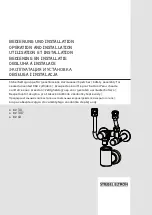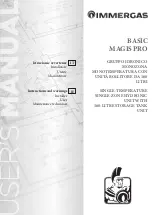
2
ABOUT YOUR BOILER
The Rio 140 is a combination boiler with an integral unvented hot water storage tank. It will supply domestic
hot water at mains pressure and provide central heating.
As all the basic components required for the central heating system and for providing domestic hot water are
fitted within the boiler, the need for external hot and cold water storage is eliminated. Therefore the system
normally has no tanks in the loft or a hot water storage cylinder.
The boiler will suit central heating systems requiring upto 28.40 kW (96 900 Btu/h), your Installer will have
adjusted the boiler output to suit the system.
The boiler is fully automatic once switched on, and will supply hot water whenever a hot tap is opened and
central heating during the periods set on the timer.
METHOD OF OPERATION (see Fig. 1 for boiler controls)
The boiler operating mode is controlled by the 'Summer/Winter' switch on the control panel. When set to
Summer, the boiler will only operate in the Domestic Hot Water mode. When set to Winter, it will operate in
the Domestic Hot Water and Central Heating mode.
Note:
The timer only controls the operating times of the central heating, not domestic hot water - this is
available continuously.
Incorporated within the boiler case is an insulated unvented domestic hot storage cylinder containing 140
litres of domestic hot water maintained at the temperature set by the adjustable hot water temperature
selector and (depending on incoming mains pressure) available at a maximum pressure of 3.5 bar.
Domestic hot water supply always takes priority over central heating. If a demand for hot water occurs during
a central heating period and reduces the store temperature to below that set by the hot water temperature
selector, the boiler automatically switches to the hot water mode until the stored water is reheated to the
temperature set by the hot water temperature selector. This interruption in the central heating should not be
noticed.
Central Heating Mode
- If there is a call for heat the pump will start to circulate the central heating water and
after a few seconds the burner will light. The burner output is automatically adjusted to match the system
demand. As the temperature of the water in the boiler approaches that set by the adjustable temperature
selector, the burner is turned off and the pump continues to run. As the heating system water cools, the
temperature drop is detected by the control system and the burner is automatically restarted for the cycle to
continue until either the timer or room thermostat stops calling for heat. The burner is then turned off (if it is
operating at the time) and the pump runs on for about 2½ minutes.
Domestic Hot Water Mode
- When a demand for hot water reduces the temperature of the stored hot water
below that set by the adjustable hot water selector, the pump starts and the burner lights, increasing to its
maximum output. Water in the boiler is then diverted from the central heating system to reheat the stored hot
water to the temperature set by the adjustable hot water temperature selector. When the stored water
reaches the selected temperature the burner is turned off and the pump stops. The boiler then returns to the
central heating mode.
In both modes the fan starts before the burner lights and stops after the burner is turned off.
CENTRAL HEATING SYSTEM
The boiler operates on a sealed central heating system which will have been pressurised by your Installer.
He will have set the red pointer on the pressure gauge (see Fig. 1), to indicate the system pressure (when
cold). Do not adjust this pointer. The grey pointer indicates the actual system pressure (between 0.8 and 1.5
bar) which will increase slightly when the boiler is operating.
If the grey pointer falls below the red pointer (when the boiler is switched off and cold), you should contact
your Service Engineer to re-pressurise the system. If the system requires re-pressurising more than once a
year, ask your Service Engineer to check the heating system for leaks.
The boiler is fitted with an automatic air vent which removes air from the system as it leaves the boiler. Any
air trapped in the radiators needs removing by venting the radiators using the vent screw at the top of the
radiators. Only vent a radiator if the top is cool and the bottom is hot. Excessive venting will reduce the
system pressure, so only vent when necessary and check the system pressure as mentioned above.
The temperature of the water leaving the boiler to the radiators can be increased by turning the heating
temperature control knob (see Fig. 1) clockwise.
The boiler will provide central heating whenever the timer is in an 'ON' period and the room thermostat (if
fitted) is calling for heat.
For summer time operation, when central heating is not required, set the 'Summer/Winter' switch (see Fig. 1)
to Summer.
Содержание RIO 140
Страница 33: ...10 WIRING DIAGRAMS 33 10 1 ILLUSTRATED WIRING DIAGRAM ...
Страница 34: ...10 WIRING DIAGRAMS 34 10 2 FUNCTIONAL FLOW WIRING DIAGRAM ...
Страница 35: ...11 SEQUENCE OF OPERATION CHARTS 35 11 1 AUTOMATIC IGNITION SEQUENCE ...
Страница 36: ...11 SEQUENCE OF OPERATION CHARTS 36 11 2 OPERATION IN CENTRAL HEATING MODE ...
Страница 37: ...11 SEQUENCE OF OPERATION CHARTS 37 11 3 OPERATION IN DOMESTIC HOT WATER MODE ...
Страница 47: ...NOTE 47 ...
Страница 54: ...6 ELECTRONIC TIMER Description of controls see Figs 3 and 4 ...
Страница 55: ...7 PROGRAMMING THE ELECTRONIC TIMER ...







































